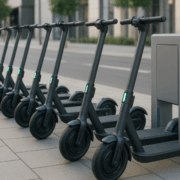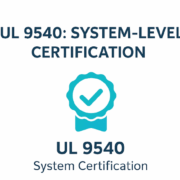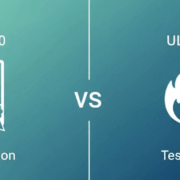UL 1642 Certification: Why It Matters for Lithium-Ion Battery Safety
What is UL 1642 Certification?: Lithium-ion batteries power nearly every aspect of our modern lives—electric vehicles, energy storage systems (ESS), consumer electronics, and medical devices. With this widespread adoption comes a heightened need for safety.
UL 1642 Certification is one of the most widely recognized safety standards for lithium-ion cells. It provides rigorous testing criteria to ensure that these cells perform reliably and minimize risks of fire, explosion, or leakage. For companies like Sunlith Energy, aligning products with UL 1642 builds trust and demonstrates commitment to global safety standards.
Understanding UL 1642: The Scope of Certification
UL 1642 specifically applies to lithium-ion and lithium-metal cells, not complete battery packs or energy storage systems.
- Scope: Evaluates individual battery cells.
- Objective: Ensures cells resist hazardous conditions such as overcharging, short circuits, and high temperatures.
- Coverage: Tests for mechanical, electrical, and environmental stress conditions.
By certifying cells under UL 1642, manufacturers establish a solid foundation for further certifications like UL 1973 (batteries for stationary use) and UL 9540 (energy storage systems).
👉 Related: UL 1973 Certification for Battery Systems
Key Testing Requirements of UL 1642
To achieve UL 1642 compliance, lithium-ion cells undergo rigorous testing protocols designed to simulate real-world hazards. These include:
1. Electrical Abuse Testing
- Overcharge tests
- Forced discharge conditions
- Short-circuit simulation
2. Mechanical Stress Testing
- Crush resistance
- Impact/shock exposure
- Vibration endurance
3. Environmental Testing
- High and low temperature cycles
- Humidity and pressure variations
- Altitude simulations
4. Fire and Safety Checks
- Flammability and explosion risk assessment
- Venting and leakage monitoring
These tests ensure that cells can handle extreme operating environments without catastrophic failure.
Why UL 1642 Certification Matters
Lithium-ion batteries are known for their high energy density, but that also makes them prone to thermal runaway if not properly managed. UL 1642 provides manufacturers, regulators, and end-users with confidence in battery safety.
Benefits of UL 1642:
- ✅ Safety Assurance: Demonstrates resistance to overheating and fire risks.
- ✅ Regulatory Compliance: Required for global exports and OEM partnerships.
- ✅ Market Trust: Strengthens brand reputation and product acceptance.
- ✅ Foundation for System Certification: A stepping stone for UL 1973 and UL 9540.
For Sunlith Energy, integrating UL 1642-certified cells into solutions ensures maximum reliability in battery energy storage systems (BESS) and beyond.
UL 1642 vs. Other UL Standards
Many people confuse UL 1642 with other UL certifications. Here’s how they differ:

| Standard | Scope | Application | Relationship |
|---|---|---|---|
| UL 1642 | Lithium-ion cells | Individual cells | Foundation for higher-level certifications |
| UL 1973 | Battery packs & modules | Stationary energy storage, EVs | Requires cell-level UL 1642 compliance |
| UL 9540 | Complete ESS | Residential & commercial | Ensures overall system safety |
| UL 9540A | Fire testing method | Lithium-ion systems | Evaluates thermal runaway propagation |
👉 Related: UL 9540 vs. UL 9540A Explained
Industries That Rely on UL 1642 Certification
UL 1642 is critical across industries where battery safety is non-negotiable:
- Energy Storage Systems (ESS): Large-scale grid and commercial storage.
- Electric Vehicles (EVs): Battery packs rely on UL 1642-certified cells.
- Medical Devices: Life-supporting electronics require safe cells.
- Consumer Electronics: Smartphones, laptops, and wearables.
- Aerospace & Defense: Mission-critical applications demand proven reliability.
By ensuring compliance, companies reduce liability and improve adoption across global markets.
Sunlith Energy and UL Compliance
At Sunlith Energy, we prioritize safety and compliance in every solution. Our expertise in battery energy storage systems (BESS) integrates UL-certified components, ensuring our clients meet international safety standards without compromise.
Whether you’re developing grid-scale energy projects or industrial ESS solutions, choosing UL 1642-certified cells is the first step in building a safe, reliable, and future-ready system.
👉 Explore more: IEC Certifications for BESS
Conclusion: Building Trust with UL 1642 Certification
As the global demand for lithium-ion batteries accelerates, UL 1642 certification remains the gold standard for cell-level safety assurance. It reduces risks, improves market acceptance, and lays the groundwork for advanced certifications like UL 1973 and UL 9540.
For energy storage innovators and partners working with Sunlith Energy, compliance isn’t just a checkbox—it’s a commitment to safety, reliability, and global leadership.
✅ Key Takeaway: UL 1642 Certification ensures lithium-ion cells meet the highest safety standards, making it a cornerstone for trusted energy storage solutions.
1. What is UL 1642 Certification?
UL 1642 is a safety standard that applies to lithium-ion and lithium-metal cells. It ensures cells can withstand electrical, mechanical, and environmental stress without causing fire, explosion, or leakage.
Frequently Asked Questions (FAQ) about UL 1642 Certification
2. Does UL 1642 cover battery packs or just cells?
UL 1642 applies only to individual cells. Battery packs and modules require additional certifications such as UL 1973 for stationary applications and UL 9540 for full energy storage systems.
3. Why is UL 1642 Certification important for lithium-ion batteries?
Because lithium-ion cells have high energy density, they can pose fire or explosion risks if not properly designed. UL 1642 testing validates that cells meet the highest safety standards, reducing liability and building market trust.
4. How does UL 1642 Certification differ from UL 1973 and UL 9540?
UL 1642: Tests individual lithium-ion cells.
UL 1973: Covers full battery modules and packs for stationary storage and EVs.
UL 9540: Ensures complete energy storage systems (ESS) meet fire and safety requirements.
👉 Related: UL 9540 Certification for BESS
5. Is UL 1642 certification mandatory?
While not legally required in every country, UL 1642 is considered a global benchmark for lithium-ion cell safety. Most manufacturers and system integrators require it for compliance and international trade.
6. Which industries rely on UL 1642-certified cells?
UL 1642 is critical in:
Aerospace & Defense
Energy Storage Systems (ESS)
Electric Vehicles (EVs)
Medical Devices
Consumer Electronics
7. How does Sunlith Energy use UL 1642-certified cells?
At Sunlith Energy, we integrate UL 1642-certified cells into our battery energy storage systems (BESS) to ensure maximum safety, reliability, and compliance for our global partners.
UL 2271 Certification: Ensuring Safe Lithium Batteries for Light Electric Vehicles
UL 2271 Certification: A Safety Standard for Modern Mobility
The popularity of light electric vehicles (LEVs) such as e-bikes and scooters has surged in cities worldwide. With this growth comes an urgent need for reliable and safe batteries. UL 2271 certification provides a trusted benchmark, ensuring lithium-ion batteries used in LEVs are tested for safety, reliability, and durability.
At Sunlith Energy, we understand that safety is not optional—it is the foundation of innovation in clean mobility. That is why UL 2271 plays a vital role in our approach to powering the next generation of transport solutions.
What is UL 2271?
UL 2271 is a standard developed by UL Solutions, titled “Batteries for Use in Light Electric Vehicle Applications.” It applies to rechargeable lithium-ion batteries and battery packs designed for vehicles like:
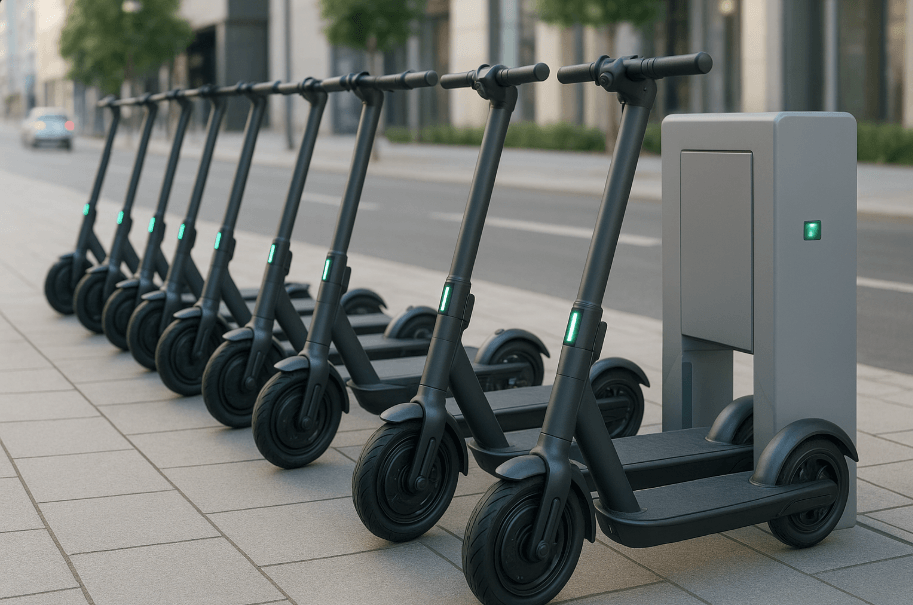
- Electric bicycles (e-bikes)
- Electric scooters
- Utility carts and campus shuttles
- Personal mobility devices
This certification addresses risks such as fire, thermal runaway, and electrical failure, giving users peace of mind while adopting electric transport.
Why UL 2271 Matters for LEVs
Lithium-ion batteries can fail under stress or misuse, sometimes causing dangerous incidents. UL 2271 reduces these risks through rigorous testing and quality checks. The benefits extend across the ecosystem:
- For Consumers – Safer rides with fewer risks of overheating or fires.
- For Manufacturers – Compliance that strengthens brand trust and accelerates market approval.
- For Regulators – A standardized approach to evaluating battery safety. Agencies such as the U.S. Consumer Product Safety Commission (CPSC) reference UL certifications when assessing risks.
- For Fleet Operators – Fewer breakdowns, lower insurance risks, and higher uptime.
By aligning with UL 2271, manufacturers demonstrate a commitment to safety and long-term reliability.
Core Testing Areas in UL 2271
The certification process is extensive, covering every aspect of battery behavior:
Electrical Performance
- Overcharge and discharge protection
- Short-circuit resistance
- Abnormal charging safety
Mechanical Safety
- Crush resistance
- Drop impact testing
- Vibration endurance
Environmental Conditions
- Temperature cycling (hot and cold)
- Humidity and corrosion exposure
- Thermal stability
Abuse Scenarios
- Nail penetration
- Fire exposure
- Forced discharge tests
These simulations ensure that batteries are safe not only under normal use but also in extreme and unexpected conditions.
Where UL 2271 Certified Batteries Are Used
Certified batteries can be found across a variety of mobility applications:
- Micromobility fleets – Shared e-scooters and bikes in urban environments
- Logistics and delivery – Small electric utility vehicles for last-mile transport
- Campus and industrial transport – Electric carts in universities, resorts, and warehouses
- Personal recreation – Electric skateboards, hoverboards, and other small vehicles
As cities embrace greener mobility, UL 2271 ensures these devices meet the highest standards of safety.
How UL 2271 Compares to Other Standards
Different UL standards apply to batteries depending on their use case. Here’s how UL 2271 fits into the bigger picture:
| Standard | Application | Key Difference |
|---|---|---|
| UL 1642 certification | Individual lithium-ion cells | Evaluates cell safety, not packs |
| UL 2054 | Consumer battery packs | Broader scope for electronics |
| UL 2271 | LEV battery packs | Designed specifically for mobility |
| UL 2580 | EV battery packs | Applied to full-size electric vehicles |
This distinction makes UL 2271 the go-to certification for smaller mobility solutions, bridging the gap between consumer electronics and large electric vehicles.
Benefits for Manufacturers
For companies producing batteries and light mobility systems, UL 2271 certification unlocks significant advantages:
- Global Market Access – Many import and sales channels require UL approval.
- Consumer Trust – Certified products carry the UL mark, a symbol of safety.
- Fewer Recalls – Certified designs lower the risk of costly failures.
- Brand Differentiation – Compliance shows leadership in product responsibility.
At Sunlith Energy, we believe certification is not only about meeting regulations but also about earning customer confidence.
Global Adoption of UL 2271
Though it originates in the United States, UL2271 is recognized worldwide. European markets, as well as regions in Asia-Pacific, increasingly request UL-certified products. Organizations like the European Committee for Electrotechnical Standardization (CENELEC) often align their safety requirements with UL or IEC standards such as IEC 62133.
Challenges in Certification
Adopting UL 2271 isn’t without hurdles:
- Testing and approval costs can be high.
- Certification takes time, which may affect product launches.
- Standards evolve as technology advances, requiring ongoing compliance updates.
However, for manufacturers committed to long-term success, the benefits outweigh the costs.
The Future of UL 2271
As micromobility grows, the importance of UL2271 will only increase. We expect:
- Tighter adoption by regulators and fleet operators.
- Integration with international standards like IEC 62133.
- Adjustments for new technologies such as semi-solid and solid-state batteries.
UL2271 will remain a critical part of ensuring that e-mobility remains safe, sustainable, and trusted.
Conclusion
UL 2271 certification is more than a technical requirement—it is a safety guarantee. For consumers, it provides assurance that their rides are reliable. For manufacturers, it opens global markets and builds trust. For regulators, it creates consistency.
At Sunlith Energy, we see UL2271 as a cornerstone in shaping a secure, innovative, and eco-friendly mobility future. Learn more about our work in certification and compliance by exploring global battery certifications.
FAQs
Q1: Does UL 2271 apply to large EVs like cars?
No. Large EVs fall under UL 2580. UL2271 is specifically designed for smaller vehicles such as scooters and e-bikes.
Q2: Is certification mandatory?
While not always legally required, many retailers, regulators, and fleet programs demand UL compliance before accepting products.
Q3: How long does certification take?
Timelines vary, but manufacturers should prepare for several weeks to months depending on design complexity.
Q4: Does UL 2271 cover battery management systems (BMS)?
Yes. The standard includes evaluations of cells, packs, and electronic control systems.
Q5: Can UL 2271 certified batteries be used in storage systems?
No. Stationary energy storage solutions fall under UL 9540/9540A.
What is Energy Storage Systems? Types of Energy Storage Systems
Introduction: The Growing Importance of Energy Storage Systems
Renewable energy is transforming the way we generate power, but sources like solar and wind are variable by nature. To make them reliable, we need Energy Storage Systems (ESS) that capture energy when it’s abundant and release it when demand is high.
At Sunlith Energy, we focus on Battery Energy Storage Systems (BESS) and advanced technologies that ensure stability, cost efficiency, and resilience across commercial, industrial, and utility sectors.
What is an Energy Storage System?
An Energy Storage System (ESS) stores energy for later use, bridging the gap between production and consumption. ESS plays a vital role in:
- Balancing supply and demand
- Reducing grid instability
- Enhancing renewable energy integration
- Lowering energy costs for businesses and communities
- Providing emergency backup power
👉 If you’re considering storage solutions for your business, explore our C&I BESS applications to see how energy storage delivers long-term value.
Types of Energy Storage Systems
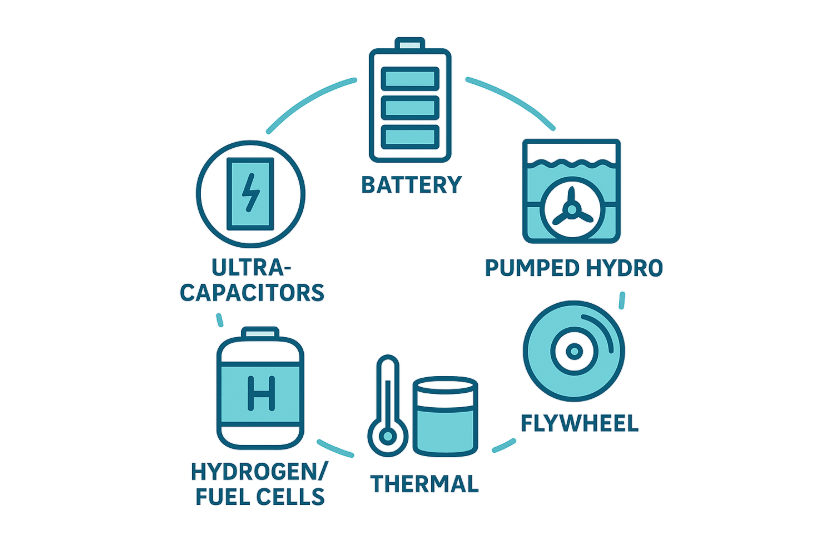
There are several types of ESS, each with unique strengths, technologies, and applications. Let’s look at them in detail:
1. Battery Energy Storage Systems (BESS)
Battery Energy Storage Systems are the most common type of ESS, offering high efficiency and scalability.
- Lithium-ion batteries – Industry standard; compact, efficient, and widely used in renewable energy storage and electric vehicles.
- Lead-acid batteries – Affordable but lower cycle life, used in smaller-scale applications.
- Flow batteries – Store energy in liquid electrolytes, ideal for long-duration storage.
👉 Learn the difference between BESS and ESS to understand their unique roles.
2. Mechanical Energy Storage
Mechanical systems store energy using physical movement or potential energy.
- Pumped Hydro Storage (PHS) – Uses water pumped uphill and released to generate electricity; highly mature technology.
- Compressed Air Energy Storage (CAES) – Stores compressed air in underground caverns and releases it to drive turbines.
- Flywheels – Store kinetic energy in a spinning rotor, providing instant power and rapid response.
3. Thermal Energy Storage Systems
Thermal ESS captures and stores energy in the form of heat or cold.
- Molten Salt – Stores solar heat for electricity generation even after sunset.
- Ice Storage – Produces and stores ice during off-peak hours for cooling buildings.
- Phase Change Materials (PCMs) – Absorb or release heat during phase transitions, providing stable temperature control.
4. Hydrogen and Power-to-X Storage
Hydrogen is a promising long-duration storage solution.
- Electrolysis converts renewable electricity into hydrogen.
- Hydrogen can be stored and later used in fuel cells, combustion turbines, or converted into synthetic fuels.
- Enables sector coupling (electricity, heating, mobility).
5. Fuel Cells
Fuel cells are not traditional storage devices, but they play a key role in energy conversion.
- They use hydrogen or other fuels to produce electricity through electrochemical reactions.
- Highly efficient and scalable for backup, mobility, and grid support.
- When paired with hydrogen storage, they form a clean and reliable energy cycle.
6. Ultra-Capacitors (Supercapacitors)
Ultra-capacitors store energy electrostatically rather than chemically, unlike batteries.
- Provide fast charging and discharging cycles.
- Best for short bursts of high power (e.g., voltage stabilization, regenerative braking).
- Typically used as a complement to batteries, not a replacement.
7. Emerging & Hybrid Energy Storage Systems
Modern ESS solutions are increasingly hybrid, combining different technologies to optimize performance. For example:
- Battery + Ultra-capacitor systems for both long-duration storage and fast response.
- Thermal + hydrogen storage for flexible renewable integration.
👉 At Sunlith Energy, we design storage systems that meet diverse needs while complying with UL Certifications and global safety standards.
Choosing the Right Energy Storage Systems
When selecting an ESS, key factors include:
- Application (backup, renewable integration, grid stability)
- Storage duration (short vs. long)
- Technology maturity & cost
- Safety and compliance standards
For commercial and industrial BESS, safety is critical. That’s why standards like UL 9540, CE and IEC certifications are vital benchmarks.
Conclusion
Energy Storage Systems are the foundation of a reliable, renewable-powered future. From batteries and mechanical systems to hydrogen, fuel cells, and ultra-capacitors, each technology has unique strengths.
At Sunlith Energy, we help industries, businesses, and utilities choose the right storage solution to maximize efficiency, lower costs, and ensure sustainability.
👉 Learn more about our Battery Energy Storage Systems and discover how we are powering the clean energy revolution.
Frequently Asked Questions (FAQ) on Energy Storage Systems
1. What is an Energy Storage System (ESS)?
An Energy Storage System (ESS) stores energy produced at one time and makes it available later when needed. It helps balance supply and demand, improves renewable energy reliability, and supports grid stability.
2. What are the main types of Energy Storage Systems?
The main types of ESS include:
Ultra-capacitors – Provide rapid charging and discharging for short-term power needs
Battery Energy Storage Systems (BESS) – Lithium-ion, lead-acid, and flow batteries
Mechanical Storage – Pumped hydro, flywheels, and compressed air
Thermal Storage – Molten salt, ice, and phase change materials
Hydrogen Storage – Converts renewable energy into hydrogen for later use
Fuel Cells – Convert hydrogen into electricity through electrochemical reactions
3. What is the difference between ESS and BESS?
ESS (Energy Storage System) is a broad term covering all types of energy storage technologies.
BESS (Battery Energy Storage System) is a specific type of ESS that uses batteries to store and release electricity.
👉 Read more: BESS vs ESS.
4. Why are Energy Storage Systems important for renewable energy?
Renewables like solar and wind are intermittent. ESS ensures that energy is stored when generation is high (e.g., sunny or windy periods) and released when demand increases, making renewable power more reliable.
5. What is the best energy storage system for commercial and industrial (C&I) use?
For most C&I applications, Battery Energy Storage Systems (BESS) are the best choice due to:
- High efficiency
- Fast response time
- Flexible scalability
- Proven reliability
👉 Learn more about C&I BESS solutions.
6. Are Energy Storage Systems safe?
Yes, modern ESS are designed with strict safety measures. Compliance with standards like CE, UL 9540 and IEC certifications ensures that systems meet global safety and performance requirements.
7. What is the future of Energy Storage Systems?
The future of ESS includes advanced solid-state batteries, wider adoption of hydrogen storage, and hybrid systems combining batteries, fuel cells, and ultra-capacitors to deliver long-duration, cost-efficient, and safe energy storage.
UL 9540 Certification for Energy Storage Systems: Complete Guide
As the demand for clean energy grows, energy storage systems (ESS) are playing a crucial role in stabilizing the grid and enabling renewable integration. With safety and compliance at the forefront, UL 9540 certification has become the global benchmark for energy storage systems.
In this guide, we’ll explain what UL 9540 is, why it matters, and how it ensures the safety of battery energy storage systems (BESS).
What is UL 9540?
UL 9540 is the Standard for Safety of Energy Storage Systems and Equipment, developed by Underwriters Laboratories (UL). It sets the requirements for the safe design, construction, installation, and performance of energy storage systems.

This standard covers:
- Battery systems (lithium-ion, lead-acid, flow batteries, etc.)
- Power conversion systems (PCS)
- Control and protection systems
- Thermal management
- Fire safety measures
By meeting UL 9540 certification, an ESS demonstrates that it can operate safely under normal and fault conditions.
Why UL 9540 Certification is Important
Energy storage systems involve high energy densities, complex electronics, and thermal risks. UL 9540 provides a structured safety framework that:
- Prevents fire hazards through strict testing protocols.
- Protects end-users by ensuring reliable and safe operation.
- Simplifies compliance with local building and fire codes.
- Supports market acceptance by meeting utility, AHJ (Authorities Having Jurisdiction), and global standards.
Without UL 9540, energy storage projects may face delays, higher insurance costs, or rejection from local authorities.
Key Components of UL 9540

UL 9540 certification is not just a single test. It integrates results from multiple safety standards, including:
- UL 1973 – for battery modules and packs.
- UL 1741 – for inverters and power conversion systems.
- UL 9540A – for thermal runaway fire propagation testing.
Together, these ensure the system-level safety of the ESS.
The UL 9540 Certification Process
The certification involves a step-by-step process:
- Application & Documentation
Manufacturers submit system specifications, schematics, and safety features. - Component Verification
Sub-systems like batteries, PCS, and BMS must comply with relevant UL standards. - System-Level Testing
The complete ESS is evaluated for electrical, mechanical, and thermal safety. - UL 9540A Fire Test (if required)
Evaluates thermal runaway risks and fire propagation between cells/modules. - Factory Audits & Quality Checks
Ensures consistent production safety.
Benefits of UL 9540 Certification
For manufacturers, developers, and customers, UL 9540 offers clear benefits:
- Market access – Approved by U.S. and international authorities.
- Insurance acceptance – Reduces risk premiums.
- Customer trust – Proof of safe and reliable operation.
- Regulatory compliance – Helps meet building codes like NFPA 855.
UL 9540 vs. UL 9540A

It’s common to confuse UL 9540 with UL 9540A.
- UL 9540 → System-level safety certification.
- UL 9540A → Fire safety test method to evaluate thermal runaway and propagation.
In practice, many jurisdictions require both UL 9540 certification and UL 9540A test reports before granting project approval.
👉 You can read our in-depth article on UL 9540A Test Method to understand how fire safety testing complements UL 9540 certification.
Applications of UL 9540 Certified Systems
UL 9540 certified systems are used across various industries:
- Commercial & Industrial facilities – backup power and peak shaving.
- Residential ESS – safe home battery storage.
- Utility-scale projects – grid balancing and renewable integration.
- Microgrids – reliable off-grid power supply.
Challenges in Achieving UL 9540 Certification
While critical, certification is not always easy. Common challenges include:
- Cost and testing timelines – Full certification can take months.
- System design complexity – Integrating batteries, PCS, and controls safely.
- Evolving standards – New revisions often add requirements.
Manufacturers must work with experienced certification partners to streamline the process.
Future of UL 9540
As energy storage technology evolves, UL continues to update its standards. Upcoming editions are expected to address:
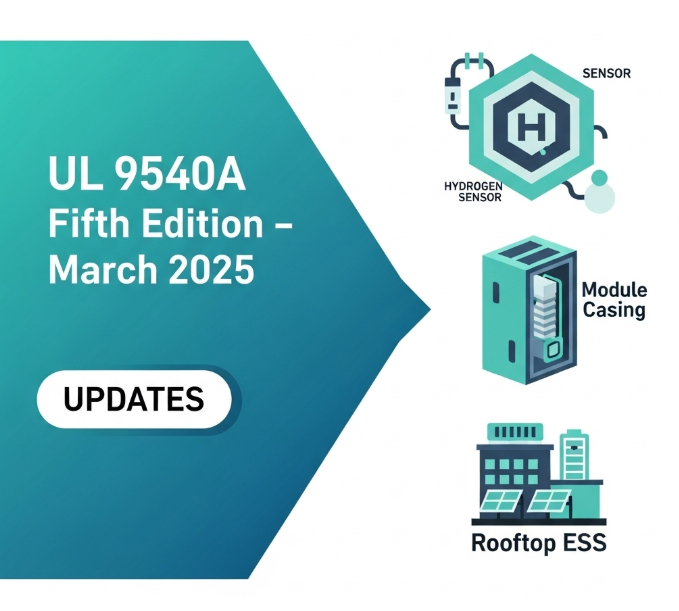
- Hydrogen detection systems
- Enhanced rooftop installation guidelines
- New battery chemistries (like sodium-ion and solid-state)
Staying aligned with these updates will be key for manufacturers and developers.
Conclusion
UL 9540 certification is the cornerstone of safety for energy storage systems. It combines multiple safety evaluations, ensures compliance with fire codes, and builds confidence among regulators, insurers, and end-users.
For anyone developing or deploying ESS solutions, UL 9540 is not optional—it’s essential.
👉 Learn more about how we support certification-ready solutions at Sunlith Energy.
FAQ: UL 9540 Certification
Q1. What does UL 9540 cover?
UL 9540 covers the safety of energy storage systems, including batteries, power conversion systems, and fire safety measures.
Q2. Is UL 9540 mandatory?
While not always legally required, many local codes and utilities demand UL 9540 certification for permitting and grid connection.
Q4. How long does certification take?
Depending on system complexity, UL 9540 certification can take 3–12 months.
Q5. Can older ESS be retrofitted for UL 9540?
Yes, but it may require re-testing and upgrades to meet safety standards.
UL 9540 vs UL 9540A: Understanding the Key Differences in Energy Storage Certification
UL 9540 vs UL 9540A: As the adoption of battery energy storage systems (BESS) grows, safety and compliance remain top priorities for regulators, manufacturers, and end-users. Two of the most recognized standards in this space are UL 9540 and UL 9540A.
Although these terms are often used together, they play very different roles in certification and safety testing. UL 9540 is a system-level certification that validates the overall safety of an energy storage system. In contrast, UL 9540A is a test method that evaluates fire risks, specifically thermal runaway and fire propagation.
At Sunlith Energy, we help manufacturers and developers navigate these certifications to ensure safe and compliant energy storage deployments.
What is UL 9540?
UL 9540 is the Standard for Safety of Energy Storage Systems and Equipment. It ensures that an entire ESS—from batteries and power conversion systems (PCS) to cooling, controls, and housing—meets strict safety requirements.
Key Features of UL 9540:
- Scope: Applies to the entire system, not just components.
- Integration: Requires batteries certified to UL 1973 and inverters certified to UL 1741.
- Safety Focus: Covers electrical, mechanical, thermal, and fire safety aspects.
- Market Approval: Often mandatory for utility-scale and commercial projects.
👉 If you’re exploring how PCS technology integrates into storage systems, check our detailed guide on Energy Storage PCS.
What is UL 9540A?
UL 9540A is the Test Method for Evaluating Thermal Runaway Fire Propagation in Battery Energy Storage Systems. Unlike UL 9540, it is not a certification but a test procedure.
This method provides critical data on how batteries behave under extreme conditions. It identifies risks such as fire spread, explosion potential, and gas emissions.
Testing Levels in UL 9540A:
- Cell Level – Individual cell behavior under failure.
- Module Level – How cells interact inside a battery module.
- Unit Level – Fire propagation within a system enclosure.
- Installation Level – Real-world system performance in buildings or outdoor setups.
👉 To understand why thermal management matters in these tests, see our post on Cooling Solutions for BESS.
UL 9540 vs UL 9540A: The Core Differences

| Feature | UL 9540 | UL 9540A |
|---|---|---|
| Type | Certification | Test Method |
| Scope | Full ESS (system-level) | Fire & thermal runaway evaluation |
| Focus | Electrical, mechanical, and fire safety | Fire propagation, gas hazards |
| Application | Required for deployment | Supports certification & AHJ approval |
| Output | Certification mark | Test report (not a certification) |
In simple terms:
- UL 9540 = Certification for market approval
- UL 9540A = Fire safety test to support certification
Why Both UL 9540 and UL 9540A Matter
The two standards work hand-in-hand:
- UL 9540 Certification validates system-level safety.
- UL 9540A Testing provides the fire risk data needed to obtain that certification.
Authorities Having Jurisdiction (AHJs) frequently demand UL 9540A reports before granting installation permits. Manufacturers, meanwhile, use test results to design safer enclosures, improve fire suppression systems, and integrate better thermal management.
👉 For more insights, see our guide on Fire Safety in BESS.
UL 9540 vs UL 9540A: Benefits of Compliance
Meeting both UL 9540 and UL 9540A requirements provides multiple advantages:
- Regulatory Compliance: Smooth permitting with AHJs and fire authorities.
- Improved Safety: Minimizes risks of fire, explosion, or hazardous gas emissions.
- Customer Confidence: Certified systems are more trusted in commercial and utility projects.
- Faster Market Access: Certification accelerates deployment timelines.
👉 Explore our complete overview of UL Certifications for Battery Systems for a deeper dive into related standards.
The Future of UL Certifications

UL standards are continuously evolving to address new technologies and risks. For example, the UL 9540A Fifth Edition (March 2025) introduced updates covering:
- Hydrogen gas detection requirements
- Fire safety for rooftop ESS installations
- Stronger casing and housing evaluations
At Sunlith Energy, we monitor these regulatory changes to help our partners stay ahead in compliance and safety.
Conclusion
When comparing UL 9540 vs UL 9540A, the key takeaway is that they are complementary, not alternatives:
- UL 9540 is the system-level certification needed for deployment.
- UL 9540A is the fire safety test method that enables certification and satisfies regulators.
Together, they provide the foundation for safe, compliant, and market-ready energy storage systems.
👉 Need guidance on achieving compliance? Connect with Sunlith Energy for expert support in certification, testing, and deployment.
UL Certifications for Battery Systems: A Complete Guide
Battery Energy Storage Systems (BESS) are becoming essential in today’s energy landscape. Whether for renewable integration, grid stability, or backup power, ensuring the safety and reliability of these systems is critical. This is where UL certifications for battery systems play a crucial role.
UL (Underwriters Laboratories) is one of the most trusted global safety certification organizations. Its standards verify that battery energy storage systems meet strict safety, fire prevention, and performance requirements. For project developers, manufacturers, and operators, understanding these certifications is not optional—it’s necessary.
In this guide, we’ll explore key UL standards such as UL 9540, UL 9540A, UL 1973, and others. You’ll also learn how these certifications impact compliance, insurance, and deployment.
At Sunlith Energy, we help businesses navigate energy storage safety and compliance while building reliable battery solutions.
Why UL Certifications Matter for Battery Energy Storage
1. Safety and Risk Mitigation
Battery systems, if not designed properly, can pose fire hazards or thermal runaway risks. UL standards ensure that systems undergo rigorous testing to minimize these risks.
2. Regulatory Approval
Most jurisdictions require UL-certified equipment for permitting. Without it, projects can face delays, redesigns, or rejection.
3. Market Trust and Bankability
Investors, insurers, and end-users trust certified systems. A BESS with UL certifications demonstrates credibility and long-term reliability.
👉 Related Read: Complete Guide to Battery Energy Storage Certification
Key UL Certifications for Battery Systems

UL 9540 – Standard for Energy Storage Systems and Equipment
UL 9540 is the primary certification for energy storage systems. It evaluates the safety, performance, and construction of complete systems, not just individual components.
- Covers batteries, Power Conversion Systems (PCS), control systems, and enclosures.
- Required for grid-scale, commercial, and residential BESS installations.
- Ensures systems meet fire safety and electrical safety standards.
Why it matters: Without UL 9540, your BESS may not receive local authority approval.
👉 Learn more about Energy Storage PCS and how it integrates into certified systems.
UL 9540A – Test Method for Evaluating Thermal Runaway Fire Propagation
UL 9540A is not a certification itself but a test method. It assesses how thermal runaway in one cell can propagate through modules, units, and installations.
- Provides data on fire propagation and suppression.
- Often required by fire marshals and building authorities.
- Supports UL 9540 certification by demonstrating safe design.
👉 Explore our article: UL 9540A Test Method Explained
UL 1973 – Batteries for Use in Stationary and Vehicle Auxiliary Power Applications
UL 1973 focuses on individual battery modules and packs used in stationary systems.
- Tests electrical, mechanical, and environmental safety.
- Covers BESS, telecom backup, and EV auxiliary batteries.
- Often a prerequisite before seeking UL 9540 certification.
UL 1741 – Inverters, Converters, Controllers
Since BESS includes PCS (Power Conversion Systems), UL 1741 applies to inverters and related power electronics.
- Validates PCS for interconnection safety with the grid.
- Ensures compatibility with renewable energy and microgrids.
- Critical for hybrid solar + storage projects.
👉 Read our guide: PCS vs Inverter – Key Differences
UL 1974 – Evaluation for Repurposing Batteries
As second-life batteries become more common, UL 1974 helps ensure repurposed cells are safe for reuse.
- Evaluates used EV or industrial batteries for BESS applications.
- Supports sustainability by extending battery life.
- Ensures recycled batteries meet minimum safety standards.
Benefits of UL-Certified Battery Systems
- Regulatory Compliance – Smooth project approvals and grid interconnection.
- Enhanced Safety – Reduced risk of fire, explosion, and system failure.
- Market Acceptance – Easier financing and insurance.
- Long-Term Reliability – Certified systems undergo rigorous life-cycle testing.
- Future-Proofing – UL standards evolve with technology, ensuring systems stay relevant.
Challenges in Achieving UL Certification
- Cost and Time: Certification requires extensive testing, which can delay projects.
- Design Changes: If a component fails testing, redesign may be necessary.
- Complex Standards: Navigating multiple UL standards can overwhelm new manufacturers.
This is where industry partners like Sunlith Energy provide support—helping companies design systems aligned with certification requirements from day one.
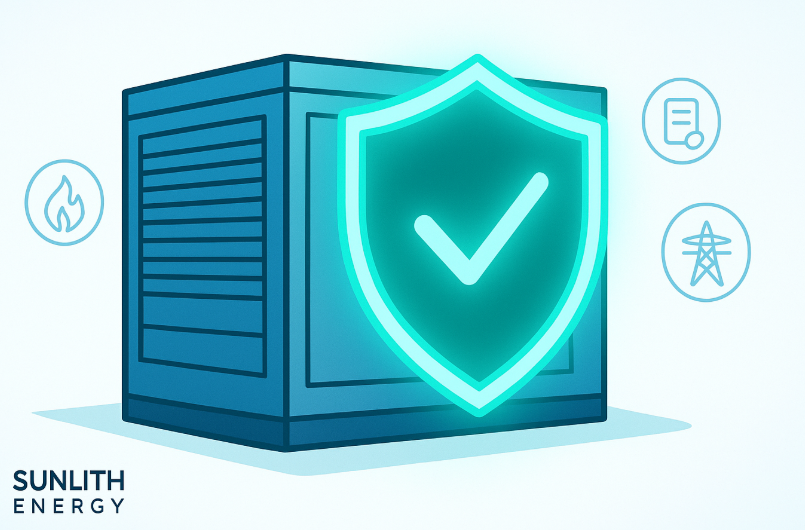
How Sunlith Energy Helps with UL-Compliant Solutions
At Sunlith Energy, we ensure that every battery system we design aligns with UL safety and certification standards. Our approach includes:
- Design Consulting: Guiding OEMs and EPCs on compliance from the design phase.
- Testing Support: Preparing systems for UL 9540, UL 9540A, and UL 1973 evaluations.
- End-to-End Solutions: Delivering certified-ready BESS with integrated PCS, battery modules, and fire safety systems.
Whether you’re deploying grid-scale storage, C&I projects, or hybrid solar + storage, our certified solutions meet the highest safety benchmarks.
👉 Learn more about our Battery Energy Storage Systems
FAQs on UL Certifications for Battery Systems
1. What is UL certification for battery systems?
It is a safety and performance evaluation that ensures battery energy storage systems meet global standards for fire safety, electrical reliability, and environmental resilience.
2. Do all BESS need UL 9540 certification?
Yes. For commercial and residential deployment in most regions, UL 9540 is mandatory.
4. How long does certification take?
Depending on system complexity, UL certification can take 6–12 months.
5. Can second-life batteries be certified?
Yes, through UL 1974, which evaluates repurposed batteries for safe use in stationary storage.
Conclusion
UL certifications for battery systems are the foundation of safe, compliant, and bankable energy storage projects. From UL 9540 system-level approvals to UL 9540A fire safety testing and UL 1973 battery-level compliance, these standards ensure that energy storage systems perform reliably under real-world conditions.
As energy storage adoption accelerates, ensuring compliance with UL standards will not just be a regulatory requirement—it will be a competitive advantage.
At Sunlith Energy, we’re committed to helping businesses deploy safe, certified, and future-ready energy storage systems.



